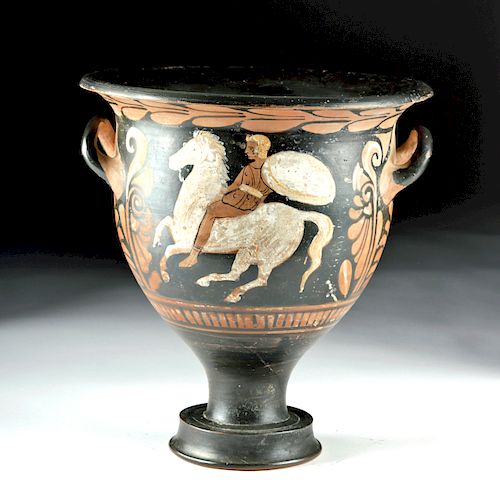Greek Campanian Bell Krater, AV Group, ex-Royal Athena
Lot 44
About Seller
Artemis Fine Arts
686 S Taylor Ave, Ste 106
Louisville, CO 80027
United States
Selling antiquities, ancient and ethnographic art online since 1993, Artemis Gallery specializes in Classical Antiquities (Egyptian, Greek, Roman, Near Eastern), Asian, Pre-Columbian, African / Tribal / Oceanographic art. Our extensive inventory includes pottery, stone, metal, wood, glass and textil...Read more
Estimate:
$12,000 - $15,000
Absentee vs Live bid
Two ways to bid:
- Leave a max absentee bid and the platform will bid on your behalf up to your maximum bid during the live auction.
- Bid live during the auction and your bids will be submitted real-time to the auctioneer.
Bid Increments
| Price | Bid Increment |
|---|---|
| $0 | $25 |
| $300 | $50 |
| $1,000 | $100 |
| $2,000 | $250 |
| $5,000 | $500 |
| $10,000 | $1,000 |
| $20,000 | $2,500 |
| $50,000 | $5,000 |
| $100,000 | $10,000 |
| $200,000 | $20,000 |
About Auction
By Artemis Fine Arts
Jun 20, 2019
Set Reminder
2019-06-20 10:00:00
2019-06-20 10:00:00
America/New_York
Bidsquare
Bidsquare : Ancient / Ethnographic From Around the World
https://www.bidsquare.com/auctions/artemis-gallery/ancient-ethnographic-from-around-the-world-4217
Around the world & back in time - be amazed at the treasures you will find. Antiquities from Egypt, Greece, Italy and the Near East, Asian, Pre-Columbian, African / Tribal / Oceanic, Native American, Spanish Colonial, Russian Icons, Fine Art, much more! All categories, all price ranges.. all legal Artemis Fine Arts info@artemisgallery.com
Around the world & back in time - be amazed at the treasures you will find. Antiquities from Egypt, Greece, Italy and the Near East, Asian, Pre-Columbian, African / Tribal / Oceanic, Native American, Spanish Colonial, Russian Icons, Fine Art, much more! All categories, all price ranges.. all legal Artemis Fine Arts info@artemisgallery.com
- Lot Description
Magna Graecia, Campanian, Capua, by a painter of Trendall's AV Group, either the Libation Painter or the Astarita Painter, ca. 340 to 320 BCE. A wonderful red-figure bell krater - a vessel used for blending wine and water - of a characteristically bell-shaped body, upturned twin loop handles, and flared rim, all upon a concave, tiered, round foot. Side A features a proud Samnite warrior, riding a valiant white horse and wielding a grand shield. Side B features a pair of draped maidens standing in profile and facing one another with a rosette in the field between them. The groundline features a fretted pattern, a band of laurel leaves graces the underside of the rim, and large stylized palmettes grace the areas below the handles with flowering tendrils to either side. The marvelous red-figure iconography is also embellished with fugitive white and red pigments, making for even more intriguing visual imagery. Size: 9.5" W handlespan x 10.875" H (24.1 cm x 27.6 cm)
According to A.D. Trendall, "Perhaps the most characteristic vases of the AV Group are those by the Libation Painter and his two chief colleagues, the Astarita and Manchester Painters (299-306). They are fond of depicting scenes with Samnite warriors, often in the company of a woman, who wears a cape fastened with a brooch at the throat, and a peculiar local headdress (300), of rather medieval aspect." (A.D. Trendall. "Red Figure Vases of South Italy and Sicily", London: Thames & Hudson, 1989, p. 165) The two opposing females on Side B of this krater fit Trendall's description.
The red-figure technique, invented in Athens around 525 BCE and beloved by artists of Magna Graecia including the painter of this bell krater, was a very exciting innovation in Greek vase painting. This technique allowed for much greater flexibility as opposed to the black-figure technique. Suddenly the artist could use a soft, pliable brush rather than a rigid metal graver to delineate interior details, play with the thickness of the lines, as well as build up or dilute glazes to create chromatic effects. The painter would create figures by outlining them in the natural red of the vase, and then enrich these figural forms with black lines to suggest volume, perspectival depth, and movement, bringing those silhouettes and their environs to life. Beyond this, fugitive pigments made it possible for the artist to create additional layers of interest and detail as we see in this example.
Provenance: ex-private New York, New York, USA collection, acquired at Royal Athena Gallery, New York, New York, USA (Royal Athena label on underside of foot)
All items legal to buy/sell under U.S. Statute covering cultural patrimony Code 2600, CHAPTER 14, and are guaranteed to be as described or your money back.
A Certificate of Authenticity will accompany all winning bids.
We ship worldwide and handle all shipping in-house for your convenience.
#141395Cracks on lower section of body - possibly pressure cracks or possibly indicative of repair. Normal surface wear commensurate with age with scuffs, nicks, and areas of pigment loss as shown, though the iconographic and decorative programs are still strong. Royal Athena label on underside of foot.Condition
- Shipping Info
-
All shipping is handled in-house for your convenience. Your invoice from Artemis Gallery will include shipping calculation instructions. If in doubt, please inquire BEFORE bidding for estimated shipping costs for individual items.
-
- Buyer's Premium



 EUR
EUR CAD
CAD AUD
AUD GBP
GBP MXN
MXN HKD
HKD CNY
CNY MYR
MYR SEK
SEK SGD
SGD CHF
CHF THB
THB
















